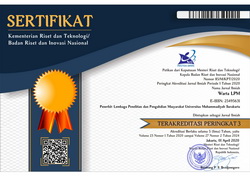Improving the Quality of Environmentally Friendly Liquid Smoke Distillation Process to Increase Artisan Income
DOI:
https://doi.org/10.23917/warta.v26i3.1631Keywords:
appropriate technology, coconut shell, distillation, liquid, smoke-liquidAbstract
The problems the Smoke-liquid Craftsman Group often faces are production capacity, product quality, and low selling prices. Low production capacity due to the limited ability distillation machine. The low quality of smoke-liquid products is due to the absence of standard quality. The smoke produced from the coconut shell charcoal production process has the potential to disturb the environment, so it has been carried out the process of melting smoke into liquid, which is then called smoke-liquid. However, the resulting smoke-liquid is still mixed with ash, brown colour, and intense aroma, and still contains much tar, so it does not meet the standard quality for food preservatives the price is low. The objective of this activity is to apply appropriate technology is carried out by enforcing standard product quality and repairing distillation machines to produce high-quality smoke liquid. This one is to support renewable and environmentally friendly energy programs while being able to increase revenue. Appropriate Technology (TTG) is in the form of improvements in distillation technology, which was previously a distiller using annular pipes, where the inner pipe is 1/2 inch. The outer pipe diameter is 1.5 inches and is changed with parallel heat pipe exchanger technology using an inner pipe with a diameter of 1 inch and an outer pipe with a diameter of 4 inches. The result of this service is prototyping a new distillation machine that can increase the production capacity and quality of liquid smoke that meets the specified standard quality and increase the selling price four times.
Downloads
References
Dahlan, M. H., Handayani, L., & Setiono, E. (2011). Pengaruh Penggunaan Membran Keramik berbasis Zeolit, Silika, dan Karbon Aktif terhadap Kadar CO dan CO2 pada Gas Buang Kendaraan Bermotor. Jurnal Teknik Kimia Universitas Sriwijaya, 17(8), 19–28.
Elly, K. (2008). Pemanfaatan Cangkang Kelapa Sawit sebagai Arang Aktif. Jurnal Penelitian Ilmu-Ilmu Teknik, 8(2), 96–103.
Gea, S., Haryono, A., Andriayani, A., Sihombing, J. L., Pulungan, A. N., Nasution, T., Rahayu, R., & Hutapea, Y. A. (2020). The Stabilization of Liquid Smoke Through Hydrodeoxygenation Over Nickel Catalyst Loaded on Sarulla Natural Zeolite. Applied Sciences, 10(12), 4126.
Hartati, S., Darmadji, P., & Pranoto, Y. (2015). Penggunaan Asap Cair Tempurung Kelapa untuk Menurunkan Kadar Timbal (Pb) pada Biji Kedelai (Glycine max). Agritech, 35(3), 331–339.
Hazeltine, B., & Bull, C. (2003). Field guide to Appropriate Technology. Elsevier.
Himawati, E. (2010). Pengaruh Penambahan Asap Cair Tempurung Kelapa Destilasi dan Redestilasi terhadap Sifat Kimia, Mikrobiologi, dan Sensoris Ikan Pindang Layang (Decapterus Spp) Selama Penyimpanan.
Ikhwan, Z. (2016). Efektivitas Penggunaan Arang Batok Kelapa sebagai Media Penyaring Penurunan Kadar Besi dan Mangan pada Penjernihan Air Kolam Penambangan Batu Bauksit. Jurnal Kesehatan, 5(2).
Kadir, S., Darmadji, P., Hidayat, C., & Supriyadi, S. (2010). Fraksinasi dan Identifikasi Senyawa Volatil pada Asap Cair Tempurung Kelapa Hibrida. Agritech, 30(2).
Ou, H. W., Fang, M. L., Chou, M. S., Chang, H. Y., & Shiao, T. F. (2020). Long-term Evaluation of Activated Carbon as an Adsorbent for Biogas Desulfurization. Journal of the Air & Waste Management Association, 70(6), 641–648.
Pangestu, E., Suswanto, I., & Supriyanto, S. (2014). Uji Penggunaan Asap Cair Tempurung Kelapa dalam Pengendalian Phytophthora sp. Penyebab Penyakit Busuk Buah Kakao Secara In Vitro. Perkebunan dan Lahan Tropika, 4(2), 39–44.
Ramadhani, S., Aswara, D., & Azriadi, E. (2022). Perancangan Insinerator Ramah Lingkungan Penghasil Arang dan Asap Cair. Jurnal Teknik Industri Terintegrasi (JUTIN), 5(1), 80–93. https://doi.org/10.31004/JUTIN.V5I1.9795
Rinaldo, D., Sari, P. A., & Sari, W. P. (2021). Perencanaan Keuangan dan Sumber Daya Manusia sebagai Upaya Perbaikan Tata Kelola Bisnis dalam Menghadapi Masa Krisis Akibat Covid-19. Warta LPM, 24(2), 319–330. https://doi.org/10.23917/warta.v24i2.12217
Septian, F. D., & Nur, M. M. (2020). Kajian Pengaruh Pemurnian Asap Cair dengan Metode Distilasi dan Adsorpsi Menggunakan Zeolit Alam. Jurnal Inovasi Ramah Lingkungan, 1(2), 4.
Sukamta, S., Sudarja, S., Pradana, C. T., & Syamsiro, S. (2020). Peningkatan Pendapatan Kelompok Pengrajin Arang Batok Kelapa Maju Adil Makmur melalui Produksi Asap Cair Berkualitas Tinggi untuk Mendukung Program Biogasoline. Prosiding Seminar Nasional Program Pengabdian Masyarakat.
Sukirman, Miftakhul Rohadi Putra, M., & Jihan Kusumawati, A. (2019). Optimalisasi Penggunaan Aplikasi Cloud Computing Sebagai. Jurnal Warta LPM, 22(2), 120–128. http://journals.ums.ac.id/index.php/warta
Talib, A., Husen, A., Sukrianto Gunawan, dan, & Talib Univ Muhammdiyah Maluku, A. (2020). Karakteristik Uji Organoleptik Ikan Cakalang Asap dengan Menggunakan Asap Cair dari Tempurung Kelapa, Sabut Kelapa dan Kayu Mangrove. Agrikan: Jurnal Agribisnis Perikanan, 13(1), 83–90. https://doi.org/10.29239/J.AGRIKAN.13.1.83-90
Tirono, M., & Sabit, A. (2011). Efek Suhu pada Proses Pengarangan terhadap Nilai Kalor Arang Tempurung Kelapa (Coconut Shell Charcoal). Jurnal Neutrino: Jurnal Fisika Dan Aplikasinya.
Wianto, T., Ahmad, D., & Arrahimi, R. (2021). Penerapan Teknologi Premium Liquid Smoke di UKM rumah Pengarang untuk Produksi Densifektan Ramah Lingkungan untuk Pencegahan Covid-19. PRO SEJAHTERA (Prosiding Seminar Nasional Pengabdian Kepada Masyarakat), 3(1).
Wulandari, F., Umiatin, U., & Budi, E. (2015). Pengaruh Konsentrasi Larutan Naoh pada Karbon Aktif Tempurung Kelapa untuk Adsorpsi Logam Cu2+. Spektra: Jurnal Fisika dan Aplikasinya, 16(2), 60–64.
Xin, X., Dell, K., Udugama, I. A., Young, B. R., & Baroutian, S. (2021). Transforming Biomass Pyrolysis Technologies to Produce Liquid Smoke Food Flavouring. Journal of Cleaner Production, 294, 125368.
Downloads
Submitted
Accepted
Published
How to Cite
Issue
Section
License
Copyright (c) 2023 Warta LPM

This work is licensed under a Creative Commons Attribution 4.0 International License.















